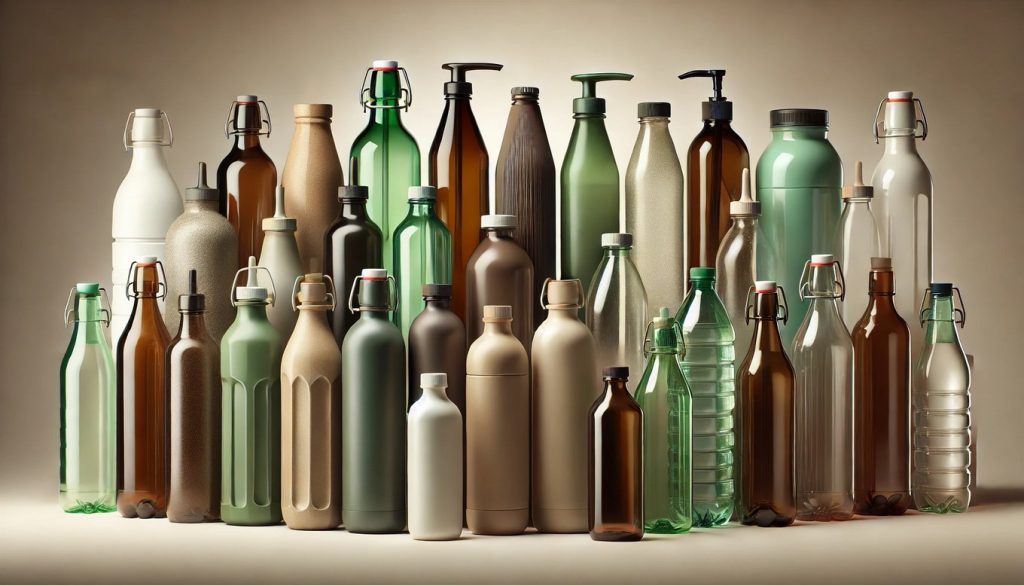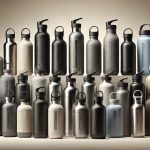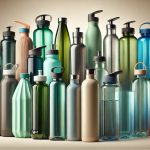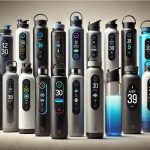In the face of growing environmental concerns and the ever-increasing use of disposable plastic, the search for sustainable, eco-friendly alternatives to single-use plastic bottles has never been more critical. Single-use alternative bottles are designed to reduce the reliance on single-use plastics by offering reusable, durable, and environmentally conscious options.
What Are Single-Use Alternative Bottles?
Single-use alternative bottles are containers designed to replace disposable plastic bottles. They are made from materials that are durable, reusable, and often more environmentally friendly than traditional plastic bottles. These bottles can be used multiple times and are designed to help reduce the waste generated by single-use plastics. By opting for these alternatives, individuals can contribute to reducing plastic pollution and promote a more sustainable lifestyle.
How Do Single-Use Alternative Bottles Work?
Single-use alternative bottles work by providing a reusable container that can be used for various liquids, including water, beverages, or other drinkables. These bottles are made from different materials like stainless steel, glass, or BPA-free plastics, offering advantages over traditional single-use plastic bottles.
- Reusable Design: These bottles are designed to withstand repeated use and can be refilled many times, ensuring you don’t need to constantly purchase disposable plastic bottles.
- Durable Materials: The bottles are often made from strong materials that resist wear and tear, ensuring long-lasting use without compromising their performance.
- Environmentally Friendly: Many of these bottles are designed to be recyclable or made from sustainable materials, further reducing their environmental impact.
- Safe to Use: Most single-use alternative bottles are BPA-free and do not contain harmful chemicals that could leach into liquids, making them safer for long-term use.
Types of Single-Use Alternative Bottles
There are several types of single-use alternative bottles, each designed for different preferences and needs. The most popular alternatives to single-use plastic bottles include stainless steel bottles, glass bottles, and BPA-free plastic bottles. Below, we’ll dive deeper into each of these options, exploring their features and benefits.
Stainless Steel Bottles
Stainless steel bottles have become one of the most popular alternatives to plastic bottles due to their durability, temperature control capabilities, and environmental benefits. These bottles are perfect for individuals looking for a long-lasting, reusable bottle that can handle tough conditions.
Features of Stainless Steel Bottles
- Temperature Insulation: Many stainless steel bottles feature double-wall insulation, which helps keep drinks cold for up to 24 hours or hot for up to 12 hours, making them ideal for all-weather hydration needs.
- Durability: Stainless steel is highly resistant to dents, rust, and corrosion, making these bottles durable enough to withstand drops, impacts, and extreme conditions.
- Non-Toxic: Stainless steel bottles are free of BPA, phthalates, and other harmful chemicals often found in plastic bottles, ensuring that your drink stays pure and safe.
- Sustainable and Reusable: Stainless steel bottles are reusable and can last for many years with proper care, which significantly reduces waste.
Common Uses of Stainless Steel Bottles
- Outdoor Adventures: Stainless steel bottles are perfect for hiking, camping, or traveling due to their durability and ability to maintain drink temperatures.
- Everyday Hydration: Whether for work, school, or daily activities, stainless steel bottles offer a safe, eco-friendly way to stay hydrated throughout the day.
- Sports and Fitness: Many athletes choose stainless steel bottles for hydration, as the insulation helps keep water or sports drinks cold during intense physical activity.
Glass Bottles
Glass bottles are a more elegant and eco-conscious alternative to plastic bottles, often chosen for their non-toxic properties and aesthetic appeal. They offer a purer taste and are a great option for those looking for an environmentally friendly bottle that doesn’t compromise on style or safety.
Features of Glass Bottles
- Non-Toxic and Chemical-Free: Glass is naturally free of BPA, phthalates, and other harmful chemicals that may leach into beverages, making glass bottles a safe choice for storing liquids.
- Pure Taste: Glass does not retain odors or flavors, ensuring that your drink tastes exactly as it should, whether it’s water, tea, or juice.
- Eco-Friendly: Glass is 100% recyclable, making it one of the most environmentally friendly materials available. Glass bottles are durable and reusable, further reducing waste.
- Aesthetic Appeal: Glass bottles are often sleek and stylish, available in various colors, designs, and shapes to match your personal preferences.
Common Uses of Glass Bottles
- Home and Office: Glass bottles are often used at home or in the office for daily hydration, as they can be filled with water or any other beverage without affecting taste.
- Health-Conscious Individuals: Glass is ideal for individuals concerned about the potential risks of drinking from plastic bottles. Glass bottles are considered one of the safest materials for storing beverages.
- Eco-Conscious Consumers: People looking to reduce their environmental footprint often choose glass bottles because they are fully recyclable and non-toxic.
BPA-Free Plastic Bottles
BPA-free plastic bottles provide an affordable, lightweight, and practical alternative to traditional plastic bottles, making them a popular choice for people looking for a safer, reusable option. These bottles are made from high-quality, non-toxic plastic that does not contain BPA or other harmful chemicals.
Features of BPA-Free Plastic Bottles
- Lightweight and Portable: Plastic bottles are lightweight, making them easy to carry, and they often come in various sizes that cater to different hydration needs.
- Safe and Non-Toxic: BPA-free plastic bottles are free from the harmful chemical Bisphenol A, which is commonly found in traditional plastics. This makes BPA-free bottles a safer alternative for storing beverages.
- Affordable: BPA-free plastic bottles are usually more affordable than stainless steel or glass options, making them accessible for a wider range of budgets.
- Durability: While not as durable as stainless steel or glass, high-quality BPA-free plastic bottles are still strong and resistant to cracking or breaking under normal conditions.
Common Uses of BPA-Free Plastic Bottles
- Everyday Use: BPA-free plastic bottles are commonly used for daily hydration needs, such as at work, school, or during a commute.
- Sports: These bottles are popular for active individuals and athletes who require a portable hydration solution during workouts or outdoor activities.
- Travel: BPA-free plastic bottles are perfect for travelers who need a lightweight, space-saving solution for staying hydrated on the go.
Materials Used in Single-Use Alternative Bottles
The materials used in single-use alternative bottles play a significant role in their overall performance, safety, and environmental impact. The most common materials used for these bottles include stainless steel, glass, and BPA-free plastic. Below, we’ll look at each material in greater detail to help you understand the advantages and considerations associated with each.
Stainless Steel
Stainless steel is a highly durable material known for its strength, resistance to corrosion, and ability to maintain the temperature of drinks. It is often used in reusable water bottles due to its robustness and long-lasting properties.
Benefits of Stainless Steel Bottles
- Durability: Stainless steel is incredibly durable, resistant to rust, corrosion, and physical damage. It’s a great option for outdoor activities or situations where the bottle may be subjected to rough handling.
- Temperature Insulation: Many stainless steel bottles come with double-wall insulation, allowing them to keep drinks hot for hours or cold for an extended period.
- BPA-Free: Stainless steel bottles are naturally BPA-free, making them a safer option compared to plastic bottles.
- Sustainability: Stainless steel bottles are durable and long-lasting, reducing the need for frequent replacements and minimizing plastic waste.
Considerations
- Weight: Stainless steel bottles are typically heavier than plastic or glass alternatives, which may be a consideration for those looking for a lighter hydration option.
- Cost: Stainless steel bottles tend to be more expensive than plastic, but their durability and temperature control benefits make them a worthwhile investment in the long term.
Glass
Glass is a classic material known for its purity, clarity, and non-toxic properties. It does not absorb odors or retain flavors, making it an excellent choice for those looking for a clean and safe bottle for hydration.
Benefits of Glass Bottles
- Non-Toxic: Glass is free from harmful chemicals like BPA, phthalates, and PVC, making it a safe choice for drinking and storing beverages.
- Pure Taste: Glass doesn’t impart any flavors or odors to the liquid inside, ensuring a clean taste.
- Eco-Friendly: Glass is fully recyclable and can be reused without degradation, making it one of the most environmentally friendly materials.
- Durability: While glass is fragile and can break when dropped, it is highly resistant to scratching and other forms of wear and tear.
Considerations
- Weight: Glass bottles are heavier than plastic or stainless steel options, making them less portable.
- Fragility: Glass is more prone to breaking if dropped, which could be a concern for people with an active lifestyle or those who frequently travel.
BPA-Free Plastic
BPA-free plastic bottles are made from high-quality plastics that do not contain Bisphenol-A, a harmful chemical found in many traditional plastic products. These bottles are lightweight, affordable, and functional, making them a popular choice for everyday hydration.
Benefits of BPA-Free Plastic Bottles
- Lightweight: Plastic bottles are much lighter than stainless steel or glass, making them easy to carry and transport.
- Affordability: BPA-free plastic bottles are often the most budget-friendly option for those seeking a reusable bottle.
- Variety: These bottles are available in a wide range of sizes, colors, and designs, allowing users to find a bottle that suits their preferences and needs.
- Durability: BPA-free plastic is strong enough to withstand normal use and is less prone to cracking or breaking compared to glass.
Considerations
- Environmental Impact: While BPA-free plastic is safer than traditional plastic, it is still a petroleum-based product, which may not be as environmentally friendly as alternatives like stainless steel or glass.
- Temperature Control: Plastic bottles do not offer the same temperature retention capabilities as insulated stainless steel bottles.
Factors to Consider When Choosing a Single-Use Alternative Bottle
Choosing the right single-use alternative bottle requires a consideration of several factors. Below are the key aspects to evaluate when selecting the best bottle for your needs:
Size and Capacity
The size and capacity of your bottle depend on your hydration needs and how long you plan to be out. For shorter trips or daily use, a smaller bottle (500 ml to 750 ml) may be sufficient. However, for longer trips or more intense physical activity, a larger bottle (1 liter or more) might be necessary.
Durability and Build Quality
Since the primary purpose of a single-use alternative bottle is to last for an extended period, durability is critical. Stainless steel and glass bottles are known for their durability and can withstand heavy use and accidental drops. BPA-free plastic bottles may be less durable but still offer strong resistance to wear and tear.
Portability and Weight
Portability is an important consideration, especially if you plan to carry the bottle during physical activities. If weight is a concern, plastic bottles are the lightest option, while stainless steel and glass tend to be heavier but more durable.
Insulation and Temperature Control
If you need a bottle that can maintain the temperature of your drink, consider getting an insulated bottle. Stainless steel insulated bottles can keep liquids cold for up to 24 hours or hot for up to 12 hours, making them perfect for outdoor activities, sports, or long commutes.
Ease of Cleaning
Choose a bottle that is easy to clean. Bottles with wide mouths or removable parts tend to be easier to clean than those with narrow openings. Some bottles are dishwasher safe, which makes cleaning even more convenient.
Design and Aesthetics
The design and aesthetic appeal of a bottle may also influence your choice. Single-use alternative bottles come in various styles, colors, and designs, allowing you to choose one that fits your personality and preferences.
Price
While single-use alternative bottles can vary significantly in price, it’s important to weigh the initial investment against long-term benefits. Stainless steel and glass bottles may come at a higher cost but offer greater durability and performance, reducing the need for replacements. BPA-free plastic bottles are generally more affordable, but their longevity may be shorter.
Environmental Impact
Lastly, consider the environmental impact of the material used in the bottle. Stainless steel and glass are often considered the most sustainable options due to their durability and recyclability. BPA-free plastic bottles, while safer than traditional plastic, are still made from petroleum-based materials and may have a larger environmental footprint. Choose a bottle that aligns with your eco-conscious values.







